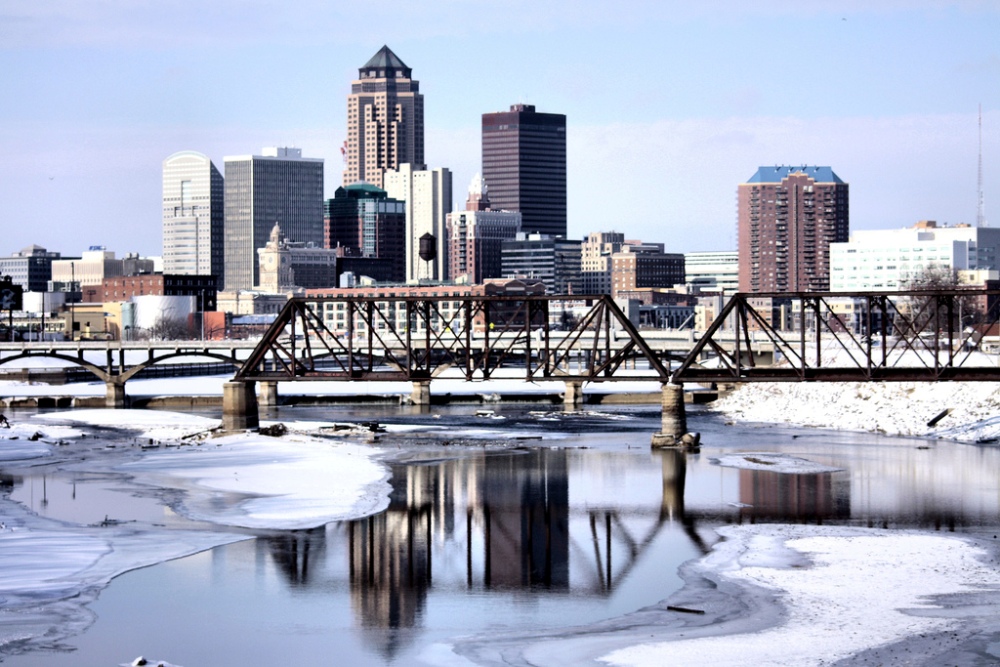
Des Moines, IA
Nitrate Pollution in Iowa's Drinking Water
Iowa is home to 24 million acres of farmland and an estimated 8,500 factory farms which generate a staggering 5 billion pounds of liquid manure annually – a significant source of nitrate pollution.
Sediment and nutrients from agricultural practices is the leading nonpoint source pollution: when rainfall, snowmelt or irrigation water run over land or through the ground and picks up pollutants and deposits them into streams, lakes, or groundwater. High levels of nutrients such as phosphorus and nitrates can cause significant health risks including blue baby syndrome (as nitrate impairs the oxygen capacity of the bloodstream; in babies and toddlers the syndrome can effectively cut off their air supply), endocrine disruption and birth defects.
In 2012, Iowa had 630 polluted waterways, the highest number of recorded polluted waterways since Iowa recording began in 1998. During the months of May and July of 2013 torrential downpours rolled off the drought-hardened soil in Iowa’s fields leading to a dramatic increase in manure contamination at intake sights on the Raccoon and Des Moines Rivers. Des Moines Water Works spent $900,000 filtering out nitrates that year as the nitrate levels reached 240% of the level allowed under the Clean Water Act. The nitrate load in Des Moines Water Works' raw water supply in one week during the summer of 2013 was greater than the enitire nitrate load in 2012.In 2014, despite differences in temperature and precipitation the nitrate load in DMWW's water supply was once again record setting.
On March 16, 2015 Des Moines Water Works filed a complaint against the Board of Supervisors or Sac, Buena Vista and Calhoun County “…in their in their capacities as trustees of 10 drainage districts, for the discharge of nitrate pollutants into the Raccoon River, and failure to obtain a National Pollutant Discharge Elimination System (NPDES) permit in violation of the Clean Water Act, in the United States District Court for the Northern District of Iowa, Western Division”, DMWW officials announced. The Raccoon River is a source of drinking to an estimated 500,000 people - one out every six Iowans.
“The complaint seeks to declare the named drainage districts are point sources pollutants, are not exempt from regulation, and are required to have a permit under federal and Iowa law. The complaint states that the drainage districts have violated and continue to be in violation of the Clean Water Act and Chapter 455B, Code of Iowa, and demands the drainage districts take all necessary actions to comply with the Clean Water Act, including ceasing all discharges of nitrate that are not authorized by an NPDES permit.”
Resources
Des Moines Water Works: Notice of Intent to Sue Protecting Your Watershed Information on Nitrate Pollutants and their Adverse Health EffectsClimate Change & Food
Climate change is affecting agriculture, water resources, human health, and ecosystems on land an in the oceans. It poses sweeping risks for economic stability and the security of nations. We can avert these risks if we take bold, decisive action now.
--Ban Ki-Moon (UN Secretary General)
Rising Temperatures & Heat Extremes can speed up crop growth. With less time to mature, yields suffer. Higher temps also promote the spread of weeds and pests that threaten yields. Further, as temperatures rise, many parasites and pathogens are also spreading infecting a greater number and area of livestock and humans. Finally, glbal tempersature rises affect water temperatures shifting fish habitiat ranges and threatening sea food supplies as well.
Precipitation cycles are shifting to more severe and frequent extremes. Where it is projected that temperatures will increase precipitation will decrease significantly - like in the major agriculture state of Iowa - crop, pasture and field yields are at risk, including the supply of freuits, vegetables and livestock. Heavy, extreme precipitation is equally threatening to food and human health. Crop and livestock losses following flood and strom damage reduce food supplies.During downpours, agrichemicals and field pathogens are washed into waterways, increasing human susceptibility to toxins and disease.
Land availability will decrease sinificantly as sea levels rise, causing farms and farmers on the coast to be displaced, along with the rest of the coastal population. As coasts move inland, flooding and salinity changes will increase stress on crops. Further stress on land will arise as desertification of previously arable land spreads with increased frequency and prolonged droughts. As crops and humans both comptete for shrinking land area, and as we lose arable land to erosion and droughts, human health is threaned by malnutrition and reduced water supplies.
Agriculture's Carbon Footprint
Climate change and agriculture have a two way exchange. It is important to realize that as much as climate change is affecting and will continue to affect food production, what and how we cultivate crops can either mitigate of furhter climate chaos. Unfortunately, today agrculture play a significant role in the anthropogenic causes of climate change. Agriculture accounts for 10% of total GHG emissions and 58% of non-CO2 emissions globally.
- Nitrous Oxide (N2O) emissions from N fertilizers, animal waste and other organic fertilizers accounts for 38% of non CO2 emissions from ag.
- Methane (CH4) emissions from enteric fermentation of ruminant livestock digestion accounts for 1/3 of all Agricultural emissions Manure management, exacerbated by Concentrated Animal Feed Operations (CAFO's) from all livestock adds more still to methane emission from agriculture.
- Global Warming Potential of both CH4 & N2O are substantially greater than that of CO2. Meaning that each pound of CH4 & N2O, warms the atmosphere equally as much as 21 & 300 pounds of CO2, respectively